How To Manually Add A Wordpress Plugin
Mar 22, 2022
Nabilla R.
5min Read
How to Install WordPress Plugins
As one of the most pop content management systems (CMS), WordPress offers loftier flexibility and numerous customization options. Information technology offers a wide variety of WordPress plugins, which permit you to tweak your website's functionality.
WordPress has its own plugin directory, which includes free and premium plugins. These plugins let yous add various features, ranging from contact forms and custom newsletters to website caching and WordPress security.
Some plugins can besides alter your WordPress site to arrive a functional online shop with a WooCommerce plugin or an eLearning platform with LMS plugins. In fact, you can fifty-fifty create your ain WordPress plugin.
In this tutorial, we volition bear witness the stride-by-step procedure of installing WordPress plugins using iii different methods. At the terminate of this commodity, we will also include a few tips you tin follow when looking for new WordPress plugins to improve your site.
How to Install WordPress Plugins From the Official Plugins Directory
The easiest way to install WordPress plugins is by accessing the official plugins directory through your WordPress admin expanse. However, this WordPress plugin directory is limited to costless plugin options merely.
Log in to your WordPress dashboard and navigate to Plugins -> Add New. Continue to search the proper noun of the plugin in the search bar. Y'all tin can too browse the featured, popular, or recommended plugins past clicking on the provided tabs on the left.
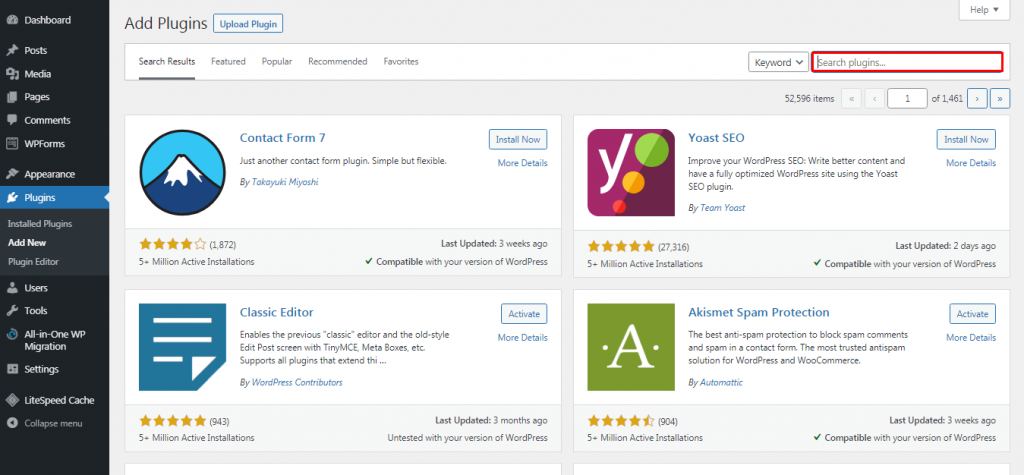
For case, if you lot search for the MonsterInsights plugin, y'all will see information technology come as the first result. Click on the Install Now button to start the plugin installation.
Wait for the process to finish and click the Actuate push button to start using the WordPress plugin.
In one case you activate the plugin, check and configure the plugin settings by heading to Plugins -> Installed Plugins.
How to Install WordPress Plugins Manually
Some other mode to install WordPress plugins is past manually uploading the plugin files through your WordPress dashboard.
This method allows you to install a plugin that may not be in the official WordPress directory but bachelor from third-party directories instead, such every bit CodeCanyon and Codester.
Before starting the plugin installation process, yous need to offset download the plugin Nil file from your chosen source.
Next, access your WordPress admin area and click Plugins -> Add together New. Then, locate the Upload Plugin button at the top-left side of the page.

Select the plugin Zippo file from your computer that you want to upload, so click Install At present.

Wait for the plugin installation to finish and press Actuate Plugin.
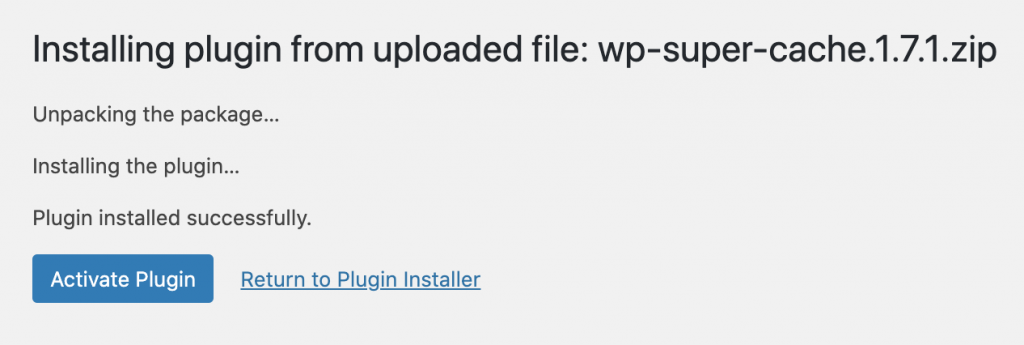
Using an FTP Client to Install WordPress Plugins
There are several premium and custom WordPress plugins that require yous to install them manually using an FTP client. For a beginner, the process might be slightly more complicated because yous will need to acquire how to configure an FTP customer get-go.
Non to worry – the following guide will walk you through the process step-by-step. All y'all have to do is merely follow the steps.
Kickoff, extract the ZIP file of the plugin and salvage it to a folder on your reckoner. Continue in mind that the extracted plugin file folder will be the one you need to upload through the FTP client.
Then, connect your website to the FTP server. To do and then, find the FTP details from your hosting provider.
For Hostinger users, simply locate the Files card on hPanel and click on FTP Accounts.
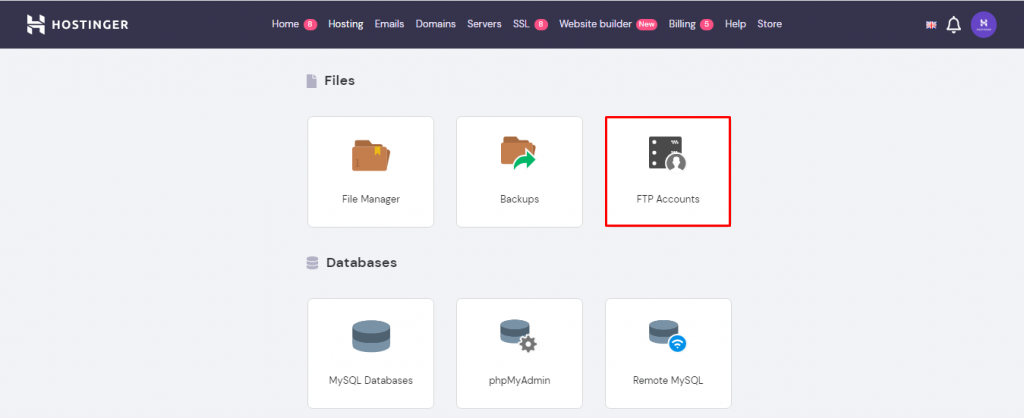
Once connected, access your FTP client – for this example, we utilise FileZilla. At that place, input your login credentials and press the Quickconnect button. Next, navigate to the Remote Site panel and locate the wp-content/plugins/ folder.
On the Local Site panel, upload the extracted plugin folder from your figurer to wp-content/plugins/ folder on your server.
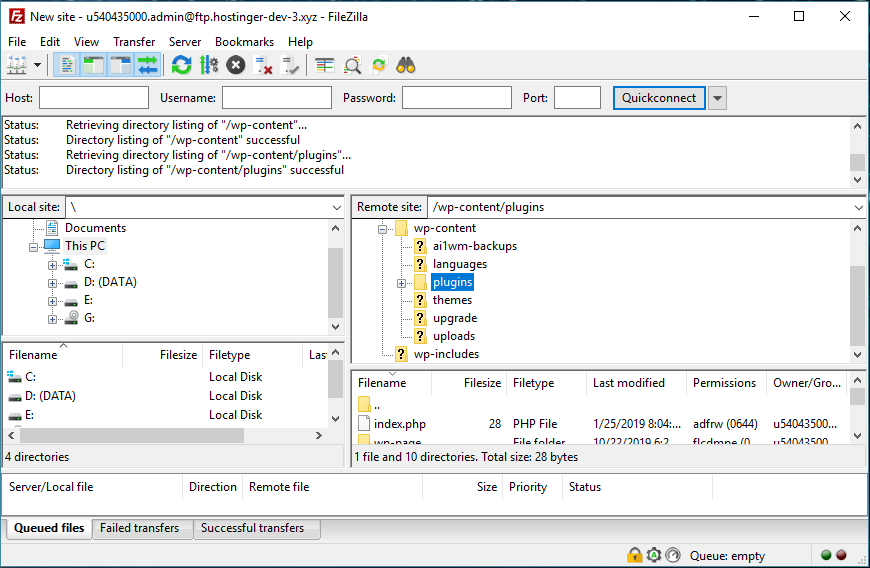
In one case the transfer is complete, the WordPress plugin will be installed on your site.
To actuate the plugin, you need to access your WordPress dashboard. Go to the plugin section -> Installed Plugins, locate the plugin, and click Actuate.
Activating Pre-Installed Plugins in hPanel
Hostinger provides a one-click WordPress installation with every shared, cloud and WordPress web hosting program. When you install WordPress through this auto-installer, y'all will go several pre-installed plugins, including LiteSpeed Cache and WPForms.
If y'all desire to actuate these plugins, access your WordPress dashboard and go to the Plugins carte. Choose the plugin you want to activate, then click on the Actuate button.
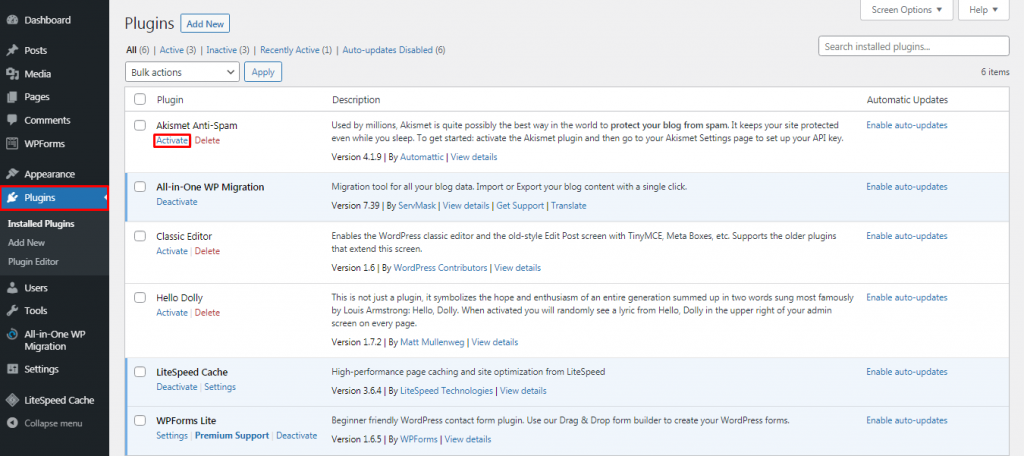
What to Call up When Selecting a Plugin?
In that location are many plugins in the WordPress plugin directory and fifty-fifty more available from third-party websites. This number of options can feel overwhelming, especially for beginners trying to figure out what'due south suitable for their site.
The post-obit sections will prove you some essential things to consider when selecting a plugin for your website.
Regular Updates.
WordPress releases regular updates to keep its system up-to-date. That's how they raise functioning, maintain security, fix bug bug, and add together new features.
And then before you install a plugin, consider these points:
- Terminal updated. Choosing a WordPress plugin that is frequently updated can prevent you from security breaches. This also shows that the developers are still actively managing and improving the plugin.
- Installation numbers. This number shows how popular said WordPress plugin is. Every bit a rule of thumb, the higher the number of active installations a plugin has, the better quality it offers.
- Ratings. Reviews and feedback from users tin aid you weigh in the pros and cons of a specific plugin. This gives yous insight into how the plugin performs in real-fourth dimension situations.
- Compatibility. A plugin that receives regular updates from its developers is ordinarily compatible with the latest version of WordPress. Always check the description tab to run into which version of WordPress is required to run the plugin.
Making Sure It Is Correct for the Job
Before you download and install a plugin to your WordPress website, be sure to cheque the claims made past the developers. Read through the plugin documentation, cheque the plugin'south support forums and read the reviews.
Researching through blog posts is as well a good practice equally many websites provide plugin reviews. At Hostinger, we also review and test WordPress plugins with diverse functionality, including menu plugins, Google Analytics plugins and review plugins.
Install I Plugin at a Time
When testing out a plugin in WordPress, remember to install and exam each plugin individually. This way, you volition quickly see if it causes whatever problems to your site and if you can fix them.
If you decide to exam several dissimilar plugins on WordPress, remember to conciliate the previous plugin before trying some other.
Moreover, when y'all take several inactive plugins, it is best to delete them as too many downloads, and installations can overload your WordPress website and impact its operation.
Utilize Only One Plugin for Each Role
Although WordPress plugins are add new features and raise your website functionality, installing too many of them tin boring your site down.
This is considering whenever yous install WordPress plugins, y'all're adding new code to your website. When used excessively, the plugins will send too many HTTP requests to load their assets, such every bit CSS stylesheets, JavaScript files, and images, slowing down your website'southward loading speed.
In addition, installing WordPress plugins that perform like functionality tin crusade conflicts, risking one or both plugins to interruption. Thus, the best practice is to install one WordPress plugin for each functionality.
For instance, both Yoast SEO and AISEO have similar sets of features – you simply need to choose one to prevent plugin conflict.
Conclusion
Nosotros hope this tutorial has helped y'all larn how to install WordPress plugins to your blog or website. Now you have the selection to enhance the functionality of your site fifty-fifty if yous have no previous technical knowledge or skills.
If you're unsure which plugin to begin with, consider what your current website lacks. And so, wait at the available plugins and compare important factors such as compatibility, reviews, and last update.
Beneath are some of our recommended essential WordPress plugins to aid yous get started:
- Yoast SEO . This plugin helps improve your WordPress weblog post and page SEO through keyword optimization and meta descriptions
- Elementor or Beaver Builder. Helps you build your website by providing an like shooting fish in a barrel-to-use elevate-and-driblet interface.
- W3 Total Enshroud or WP Super Enshroud. Boosts your website performance and reduces loading time by caching and integrating with CDN.
- Google XML Sitemaps. Automatically generates XML sitemaps for better search engine optimization.
- Akismet Spam Protection. This plugin detects and filters out spam in your comments and contact grade submissions to prevent any malicious attacks.
If you feel similar there are more essential plugins that a website may need, permit u.s.a. know in the comments below.
How To Manually Add A Wordpress Plugin,
Source: https://www.hostinger.com/tutorials/wordpress/how-to-install-wordpress-plugins
Posted by: mizerruchoculd1984.blogspot.com


0 Response to "How To Manually Add A Wordpress Plugin"
Post a Comment